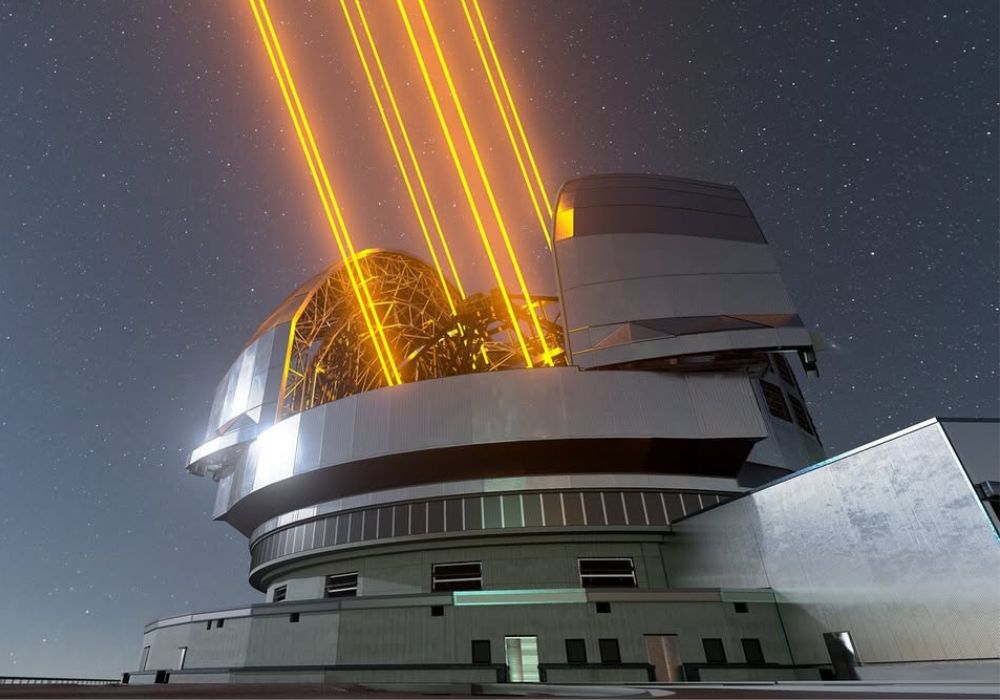NASA Reveal Groundbreaking New Telescope Could Detect Alien Life Within ‘Hours’

Have you ever stood beneath a starry sky and wondered: Are we truly alone? The vastness of space, the endless black expanse dotted with distant stars and galaxies, holds a mystery that has captured the human imagination for centuries. We look up, our minds filled with questions about what lies beyond—about other worlds, other lives, and perhaps, other civilizations.
For generations, scientists have been reaching for the stars, developing technologies to answer this eternal question. But despite our best efforts, finding proof of alien life has always felt just out of reach. That is, until now.
NASA has just unveiled a groundbreaking new telescope, one that could revolutionize the search for life beyond Earth. This isn’t just another piece of technology—this is a game-changer. For the first time, we have a telescope that could detect signs of alien life in just a matter of hours. Yes, you read that right: in hours, not years.
As humanity stands on the precipice of one of its greatest technological advancements, the question is no longer “Can we find alien life?” but “How soon will we find it?” The next chapter in the quest to answer one of the most profound questions in human history is unfolding, and it promises to bring us closer to the stars than we ever imagined.
Searching for Life Beyond Earth
Since the dawn of human consciousness, we have gazed up at the night sky and wondered: Are we alone in the universe? Ancient civilizations looked to the stars, weaving stories of gods, spirits, and extraterrestrial beings. But it wasn’t until the dawn of modern science that we began to ask the question more systematically—Is there life beyond Earth?
This question has fueled our greatest scientific endeavors. From the first telescope peering into the depths of space to the sophisticated space probes that have traveled farther than we ever could have dreamed, humanity has sought answers to one of the most profound mysteries of existence. The quest to find alien life is not just about the search for another civilization; it’s about understanding the very essence of life itself.
But let’s be real: the search has not been easy. Space is vast—mind-bogglingly vast—and for all our technological advancements, our efforts have often been limited by the tools we have at our disposal. Detecting alien life—if it exists—has always felt like finding a needle in a cosmic haystack. We’ve sent signals out into the void, launched rovers to explore distant planets, and even trained telescopes to study distant stars. Yet, despite all our efforts, we still haven’t found that definitive sign: a clear, undeniable signal that says, “We are not alone.”
The journey has been slow, methodical, and often frustrating. It has taken years—sometimes decades—just to gather the faintest hints that there might be something out there. But with the unveiling of NASA’s new telescope, we stand on the verge of a monumental breakthrough.
This new telescope is not just a tool; it represents a shift in how we approach the search for alien life. It promises to answer the question that has consumed humanity for so long, and it promises to do so at a speed and clarity that we’ve never experienced before.
This telescope isn’t about just searching the stars for the faintest of signals; it’s about finally giving us the ability to listen clearly, to see with unprecedented precision, and to determine whether life exists beyond our planet—not in years, but in hours.
NASA’s Groundbreaking New Telescope
What makes this new telescope so special? It’s not just bigger—it’s smarter.
At the heart of this groundbreaking development is a technological marvel that’s set to change everything we know about space exploration. NASA’s new telescope is more than just a scientific tool—it’s a giant leap forward in our quest to understand life beyond Earth. It promises to unlock the mysteries of the cosmos in a way that was once unimaginable.
This telescope, still under construction, is unlike anything we’ve ever built before. Its primary mirror is a staggering 39 meters (128 feet) across, making it one of the largest optical telescopes in the world. To put that into perspective, it’s 15 times more powerful than any telescope currently in existence. This immense size allows the telescope to gather vastly more light, enabling scientists to see further and with greater clarity than ever before.
But size alone isn’t what sets it apart. What makes this telescope truly revolutionary is its ability to observe distant exoplanets—and more specifically, to detect the chemical signatures that could point to the presence of life. These “biosignatures,” as scientists call them, are the key to understanding whether alien life exists on other worlds. By studying the light that filters through an exoplanet’s atmosphere, the telescope will be able to identify key molecules—such as water vapor, oxygen, and methane—that might indicate the presence of life.
This is where the magic happens. For years, astronomers have been gathering data on exoplanets, searching for these biosignatures. However, detecting these faint signals has traditionally been a slow process, often taking years or even decades to confirm. The new telescope, however, revolutionizes this process.
What’s truly groundbreaking is its speed. The telescope’s advanced technology allows it to scan distant worlds with incredible precision and identify these biosignatures much faster than ever before. In fact, simulations show that it could detect life on planets just a few light years away in as little as 10 hours.
This is more than just a technological leap; it’s a new era in our search for alien life. The ability to gather this kind of data in such a short amount of time means that we could soon have the answers we’ve been seeking for centuries—and we could have them sooner than we ever expected.
Unlocking the Universe’s Secrets—At Unprecedented Speed
For decades, the search for alien life has been a slow, painstaking process—one that demanded years of observation and careful analysis. Detecting even the faintest hint of life on distant exoplanets has traditionally taken years, often involving complicated techniques to identify biosignatures in the atmosphere. But with NASA’s new telescope, all that is about to change. The game is changing, and the pace of discovery is about to accelerate in ways we never thought possible.
Imagine this: in just 10 hours, scientists could gather enough data to determine whether life exists on an exoplanet orbiting Proxima Centauri, the closest known star to our own Sun. Ten hours. It’s almost hard to fathom that something as profound as the existence of life beyond Earth could be determined so quickly. Yet, that’s exactly the kind of possibility that this new telescope presents.
This remarkable speed comes from the telescope’s sheer power and precision. By utilizing cutting-edge technology and innovative methods, it can scan planets, analyze their atmospheres, and identify the key chemical signatures of life in record time. In just an hour, it could even determine whether a Neptune-sized planet, with its thicker atmosphere, might harbor life. For comparison, current methods would take years to achieve the same results.
This is a monumental shift. We are no longer confined to slow and incremental progress—we now have the potential to speed up our search for life and open new doors to understanding the cosmos. The ability to detect alien life in hours, not decades, will transform the way we approach space exploration and revolutionize our search for answers to one of humanity’s oldest questions: Are we alone?
But beyond the speed, this leap forward represents something more profound. It’s a symbol of progress, a reminder that as human beings, we have the capacity to innovate, to overcome obstacles, and to turn the impossible into the possible. Just as we’ve built this telescope to peer across the stars, we have the ability to push forward, to advance not just our technology but also our own understanding of what’s out there—and what’s within ourselves.
The power to detect life in just hours could change everything. With this new telescope, we will no longer be passive observers of the universe—we will be active participants, gathering the answers to questions that have haunted us for centuries, in real time, and with unprecedented clarity. The time for discovery is now. And it’s faster than we ever imagined.
What Would Discovering Alien Life Mean for Us?
The discovery of alien life, if it were to occur, would undoubtedly be one of the most significant moments in human history. It’s a discovery that could fundamentally alter our perception of existence itself. For centuries, humanity has pondered whether we are alone in the universe. The implications of discovering life beyond Earth are both thrilling and humbling. On one hand, such a discovery would confirm that we are not the only intelligent, life-bearing beings in the cosmos. On the other, it could challenge our deeply ingrained notions about the uniqueness of human life and our place in the universe.
But beyond the philosophical and emotional impact, the discovery of alien life could also have practical consequences. It could spark a new wave of technological innovation, as scientists and engineers work to better understand alien life forms and the environments that sustain them. The search for alien biosignatures could lead to breakthroughs in areas like bioengineering, medicine, and environmental science, as researchers study the ways in which alien life adapts to different conditions. In this way, the discovery of alien life could have far-reaching benefits for humanity, inspiring a new generation of scientists and innovators.
Moreover, the realization that life exists beyond Earth could unite humanity in a way that few other events could. The knowledge that we share the universe with other forms of life could inspire a sense of global solidarity, fostering greater cooperation among nations in the pursuit of knowledge and discovery. It could encourage us to reflect on our own planet’s fragility and the need to protect it for future generations. In this sense, the discovery of alien life might not only change our understanding of the universe, but also our approach to life here on Earth.
Embracing the Infinite Possibilities
NASA’s new telescope isn’t just a big step for science—it’s a big step for all of us. Its ability to detect signs of life in just hours brings us closer than ever to answering the age-old question: Are we alone? But even more than that, it shows what we can do when we stay curious and keep pushing forward.
This telescope is a reminder that we’re capable of incredible things. It took vision, teamwork, and years of hard work to build. And that same drive—the desire to learn, grow, and explore—is something we all carry. Whether we’re chasing dreams here on Earth or looking for life beyond it, the spirit is the same.
The sky isn’t the limit—it’s just the beginning. This telescope is proof that when we reach for something bigger, we get closer to understanding not just the universe, but ourselves. So let’s keep asking questions, keep exploring, and never stop reaching for more.
Featured Image Source: The European Southern Observatory on Instagram
Loading...






